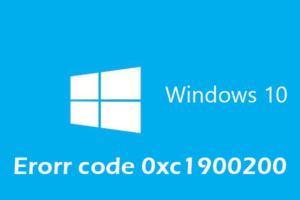-
Table of Contents
- Understanding the Causes of Windows Boot Loop and How to Fix It
- Step-by-Step Guide to Restoring Your Previous Version of Windows in Boot Loop
- Common Mistakes to Avoid When Restoring Your Previous Version of Windows Boot Loop
- Tips and Tricks for Preventing Windows Boot Loop and Ensuring System Stability
- Q&A
Break free from the boot loop: Restore your previous version of Windows.
Restoring your previous version of Windows boot loop refers to a situation where your computer repeatedly restarts and gets stuck in a loop while attempting to restore a previous version of the Windows operating system. This can occur due to various reasons, such as a failed Windows update or a corrupted system file. Resolving this issue requires troubleshooting steps to break the boot loop and restore your computer’s functionality.
Understanding the Causes of Windows Boot Loop and How to Fix It
Restoring Your Previous Version Of Windows Boot Loop
Understanding the Causes of Windows Boot Loop and How to Fix It
Windows boot loop is a frustrating issue that many users encounter at some point. It occurs when your computer repeatedly restarts during the boot process, preventing you from accessing your desktop. This can be a major inconvenience, especially if you have important files or work that you need to access. In this article, we will explore the causes of Windows boot loop and provide you with some solutions to fix it.
One of the common causes of Windows boot loop is a corrupted system file. This can happen due to a sudden power outage, improper shutdown, or a malware infection. When a critical system file becomes corrupted, it can disrupt the boot process and cause your computer to enter a loop of restarting. To fix this issue, you can try restoring your previous version of Windows.
Restoring your previous version of Windows can be done by accessing the Advanced Startup Options. To do this, you need to restart your computer and press the F8 key repeatedly until the Advanced Startup Options menu appears. From there, you can select the option to restore your previous version of Windows. This will revert your computer back to a previous state, before the boot loop issue occurred.
Another possible cause of Windows boot loop is a faulty hardware component. If you recently installed new hardware or made changes to your computer’s hardware configuration, it could be causing the boot loop problem. In this case, you may need to remove or replace the faulty hardware to resolve the issue. It is recommended to consult a professional technician if you are not familiar with hardware troubleshooting.
In some cases, a software conflict can also trigger the Windows boot loop. This can happen when incompatible software or drivers are installed on your computer. To fix this issue, you can try booting your computer in Safe Mode. Safe Mode allows you to start your computer with only the essential drivers and services, which can help identify and resolve any software conflicts. Once in Safe Mode, you can uninstall any recently installed software or drivers that may be causing the boot loop.
If none of the above solutions work, you may need to consider performing a clean installation of Windows. This involves formatting your hard drive and reinstalling the operating system from scratch. Before proceeding with a clean installation, it is important to back up your important files and data, as this process will erase everything on your computer. You can use an external hard drive or cloud storage to create a backup of your files.
In conclusion, Windows boot loop can be a frustrating issue that prevents you from accessing your computer. Understanding the causes of this problem, such as corrupted system files, faulty hardware, or software conflicts, can help you find the appropriate solution. Restoring your previous version of Windows, removing faulty hardware, or uninstalling incompatible software are some of the possible fixes. If all else fails, a clean installation of Windows may be necessary. Remember to back up your files before attempting any major changes to your system.
Step-by-Step Guide to Restoring Your Previous Version of Windows in Boot Loop
Restoring Your Previous Version Of Windows Boot Loop
If you find yourself stuck in a boot loop after a recent Windows update or installation, don’t panic. This frustrating issue can be resolved by restoring your previous version of Windows. In this step-by-step guide, we will walk you through the process of restoring your previous version and getting your computer back up and running smoothly.
Firstly, it’s important to understand what a boot loop is. A boot loop occurs when your computer repeatedly restarts without successfully loading the operating system. This can happen due to various reasons, such as incompatible drivers, corrupted system files, or failed updates. Restoring your previous version of Windows can help resolve these issues and bring your computer back to a stable state.
To begin the restoration process, you will need to access the Advanced Startup Options. Start by turning on your computer and repeatedly pressing the F8 key until the Advanced Startup Options menu appears. If this doesn’t work, you may need to consult your computer’s manual or manufacturer’s website for the specific key combination to access this menu.
Once you have accessed the Advanced Startup Options menu, select the “Troubleshoot” option. This will open a new window with several troubleshooting options. Choose “Advanced options” and then select “System Restore.” System Restore is a built-in feature in Windows that allows you to revert your computer’s settings to a previous point in time.
After selecting System Restore, you will be prompted to choose a restore point. A restore point is a snapshot of your computer’s system files and settings at a specific point in time. It’s recommended to choose a restore point that was created before the boot loop issue started. Select the desired restore point and click “Next.”
Before proceeding with the restoration, it’s important to note that System Restore will not affect your personal files, such as documents, photos, or videos. However, any software installations or system changes made after the selected restore point will be lost. If you have any important files or data that you haven’t backed up, it’s advisable to do so before proceeding.
Once you have confirmed the restore point and understood the potential consequences, click “Finish” to begin the restoration process. Your computer will then restart and initiate the restoration. This process may take some time, so be patient and avoid interrupting it.
After the restoration is complete, your computer will restart again, and you should no longer be stuck in the boot loop. Your previous version of Windows will be restored, and any issues that were causing the boot loop should be resolved. You can now log in to your computer and continue using it as usual.
In conclusion, a boot loop can be a frustrating experience, but restoring your previous version of Windows can help resolve the issue. By following the step-by-step guide outlined above, you can successfully restore your computer’s settings to a previous point in time and get your system back up and running smoothly. Remember to choose a restore point that predates the boot loop issue and to back up any important files before proceeding. With patience and careful execution, you can overcome the boot loop and regain control of your computer.
Common Mistakes to Avoid When Restoring Your Previous Version of Windows Boot Loop
Restoring Your Previous Version of Windows Boot Loop can be a frustrating experience for many users. It is a common issue that occurs when attempting to revert back to a previous version of Windows. However, there are several mistakes that users often make during this process that can further complicate the situation. In this article, we will discuss some of these common mistakes and provide tips on how to avoid them.
One of the most common mistakes that users make when trying to restore their previous version of Windows is not properly backing up their data. It is crucial to create a backup of all important files and documents before attempting any major system changes. This will ensure that you have a copy of your data in case anything goes wrong during the restoration process. Neglecting to back up your data can result in permanent loss of files, which can be devastating.
Another mistake that users often make is not following the correct steps for restoring their previous version of Windows. It is important to carefully follow the instructions provided by Microsoft or any other reliable source. Skipping steps or performing them out of order can lead to errors and further complications. Take the time to read and understand the instructions before proceeding with the restoration process.
Furthermore, users sometimes fail to check for compatibility issues before attempting to restore their previous version of Windows. It is essential to ensure that your hardware and software are compatible with the version you are trying to restore. Incompatible hardware or software can cause the restoration process to fail or result in other issues. Before proceeding, check the system requirements and compatibility information provided by Microsoft or the software manufacturer.
Another mistake to avoid is interrupting the restoration process. Restoring your previous version of Windows can take some time, depending on the size of your data and the speed of your computer. It is important to be patient and allow the process to complete without interruption. Interrupting the restoration process can lead to incomplete or corrupted system files, which can cause further problems down the line.
Additionally, users often neglect to update their drivers and software after restoring their previous version of Windows. It is crucial to update all drivers and software to ensure compatibility and optimal performance. Outdated drivers and software can cause system instability and other issues. Take the time to check for updates and install them after the restoration process is complete.
Lastly, users sometimes forget to reinstall necessary applications and programs after restoring their previous version of Windows. It is important to reinstall any applications or programs that were not included in the restoration process. Failure to do so can result in missing features or functionality. Make a list of all the applications and programs you need and reinstall them after the restoration process is complete.
In conclusion, restoring your previous version of Windows Boot Loop can be a complex process, but avoiding common mistakes can help make it smoother and more successful. Remember to back up your data, follow the correct steps, check for compatibility issues, avoid interrupting the process, update drivers and software, and reinstall necessary applications and programs. By avoiding these mistakes, you can increase the chances of a successful restoration and minimize any potential issues.
Tips and Tricks for Preventing Windows Boot Loop and Ensuring System Stability
Restoring Your Previous Version Of Windows Boot Loop
Windows boot loop is a frustrating issue that many users have encountered at some point. It occurs when your computer repeatedly restarts during the boot process, preventing you from accessing your desktop. This can be caused by a variety of factors, such as a recent software update or a corrupted system file. Regardless of the cause, it is essential to address this issue promptly to restore your computer’s functionality.
One effective solution to resolve the Windows boot loop is to restore your previous version of Windows. This can be done by accessing the Advanced Startup Options menu, which provides various troubleshooting tools. To access this menu, you need to interrupt the boot process three times in a row. This can be achieved by pressing the power button on your computer when the Windows logo appears, and then repeating this process two more times.
Once you have successfully accessed the Advanced Startup Options menu, you can navigate to the Troubleshoot section. From there, select Advanced Options and then choose System Restore. This will allow you to restore your computer to a previous state, effectively undoing any recent changes that may have caused the boot loop.
It is important to note that this method will only work if you have previously created a restore point. Windows automatically creates restore points before major system changes, such as installing updates or new software. However, if you have not manually created a restore point, this option may not be available to you.
If restoring your previous version of Windows does not resolve the boot loop issue, there are other steps you can take to ensure system stability and prevent future occurrences. One crucial step is to keep your operating system and software up to date. Regularly installing updates and patches can help fix bugs and vulnerabilities that may cause system instability.
Additionally, it is essential to regularly scan your computer for malware and viruses. Malicious software can disrupt the normal functioning of your system and potentially lead to a boot loop. Using reputable antivirus software and performing regular scans can help detect and remove any threats.
Another tip for preventing boot loop issues is to be cautious when installing new software or drivers. Incompatible or poorly designed software can conflict with your system, leading to instability and boot loop problems. Before installing any new software, it is advisable to research its compatibility with your operating system and read user reviews to ensure it is reliable.
Furthermore, maintaining a clean and organized system can contribute to its stability. Regularly deleting unnecessary files, clearing temporary files, and defragmenting your hard drive can help optimize your computer’s performance and prevent potential issues.
In conclusion, experiencing a Windows boot loop can be frustrating, but there are steps you can take to resolve the issue and prevent future occurrences. Restoring your previous version of Windows can be an effective solution, provided you have a restore point available. Additionally, keeping your system up to date, scanning for malware, being cautious when installing new software, and maintaining a clean system can all contribute to system stability and prevent boot loop problems. By following these tips and tricks, you can ensure a smooth and uninterrupted computing experience.
Q&A
1. How can I restore my previous version of Windows if I’m stuck in a boot loop?
You can try accessing the Advanced Startup Options by repeatedly pressing the F8 key during boot. From there, select “Troubleshoot” > “Advanced options” > “System Restore” to restore your previous version of Windows.
2. What should I do if the System Restore option doesn’t work?
If System Restore fails, you can try using the “Startup Repair” option in the Advanced Startup Options. This tool can automatically fix certain issues that may be causing the boot loop.
3. Is there any other method to restore the previous version of Windows?
If the above methods don’t work, you can try using a Windows installation media (such as a USB or DVD) to boot into the Windows Recovery Environment. From there, you can access the “System Restore” or “Startup Repair” options to restore your previous version of Windows.
4. Will restoring the previous version of Windows delete my files?
Restoring the previous version of Windows should not delete your personal files. However, it’s always recommended to back up your important data before attempting any system restore or repair process, just to be safe.Restoring your previous version of Windows boot loop occurs when the operating system fails to start properly and continuously attempts to revert to a previous version. This can be caused by various factors such as incompatible software or driver updates, system file corruption, or hardware issues. To resolve this issue, you can try booting into Safe Mode and performing a system restore, using the Windows Recovery Environment, or reinstalling Windows. It is recommended to backup your important files before attempting any troubleshooting steps.







![[Solved]: “Error Code 0xC004F050” in Windows 11 in No Time](https://www.tipsbin.net/wp-content/uploads/2023/08/8e64f519d2390bfc001a41744be2cbd4-300x199.jpeg)

